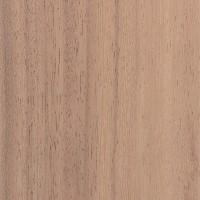 |
Common Name(s): Monkeypod, Monkey Pod, Raintree Scientific Name: Albizia saman (syn. Samanea saman, Pithecellobium saman) Distribution: Central and South America (Also planted/naturalized in many tropical regions of the world) Tree Size: 100-125 ft (30-38 m) tall, 3-4 ft (1-1.2 m) trunk diameter Average Dried Weight: 38 lbs/ft3 (600 kg/m3) Specific Gravity (Basic, 12% MC): .48, .60 Janka Hardness: 900 lbf (4,010 N) Modulus of Rupture: 9,530 lbf/in2 (65.7 MPa) Elastic Modulus: 1,149,000 lbf/in2 (7.92 GPa) Crushing Strength: 5,790 lbf/in2 (39.9 MPa) Shrinkage: Radial: 2.0%, Tangential: 3.4%, Volumetric: 6.0%, T/R Ratio: 1.7 |
Color/Appearance: Color tends to be a golden to dark brown, sometimes with darker streaks. Sapwood is usually thin and yellow/white, clearly demarcated from the heartwood. Monkeypod is sometimes seen with highly figured curly or wild grain patterns.
Grain/Texture: Grain is usually straight, but can also be interlocked or wavy. Texture is medium to coarse, with medium to large open pores and a moderate natural luster.
Endgrain: Diffuse-porous; large to very large pores in no specific arrangement, very few to few; solitary and radial multiples of 2-3; heartwood deposits occasionally present; narrow rays usually not visible without lens, normal spacing; parenchyma vasicentric, lozenge, and confluent.
Rot Resistance: Rated as durable to very durable regarding decay resistance, Monkeypod is also resistant to most insect attacks.
Workability: Monkeypod is generally easy to work with both hand and machine tools, though any interlocked grain may result in fuzzy or torn grain during planing operations. Glues and finishes well.
Odor: No characteristic odor.
Allergies/Toxicity: Although severe reactions are quite uncommon, Monkeypod wood dust has been reported as an eye irritant. See the articles Wood Allergies and Toxicity and Wood Dust Safety for more information.
Pricing/Availability: Available as lumber, as well as craft wood in smaller sizes. Prices are in the mid to high range for imported wood. Monkeypod usually trends a little bit cheaper in price than Koa, all other things being equal. Boards with figured grain patterns are much more expensive.
Sustainability: This wood species is not listed in the CITES Appendices or on the IUCN Red List of Threatened Species.
Common Uses: Veneer, plywood, millwork/trim, carving, cabinetry, furniture, musical instruments (guitars and ukuleles), and other small specialty wood items.
Comments: So named for the spiral-shaped fruit pods which the tree bears. Outside of Hawaii, one of the most common names for the species is Raintree, which is due to the leaves’ tendency to fold up at night or during periods of rainfall, allowing rain to pass through its broad canopy to the vegetation below. Trees are commonly planted in tropical regions as an ornamental shrub or shade tree.
Monkeypod is called by many different names in many different cultures, and its lumber is likewise used for a number of different purposes depending on the locale, ranging from utility wood and construction purposes to fine furniture.
None available.
Scans/Pictures: A special thanks to Holger Tebert for providing the picture of the speaker cabinets.


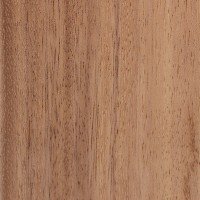
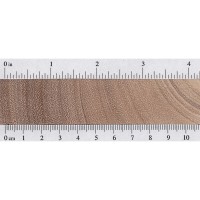
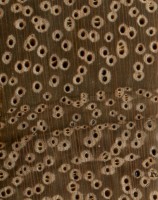
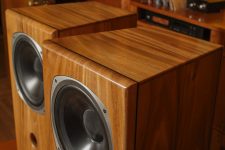



Considering Monkey Pod with epoxy filler and sealed but live in Vegas with next to no humidity and it would be used for an outdoor bar top under a cover.
Will it put up to the heat and lack of humidity?
made this entry way table from monkeypod. Fractal burned and epoxy resin finish
I recently made this knife block from monkeypod – turned out beautiful!
I have a monkey pod coffee table that my dad bought while stationed in Hawaii, 1950’s. I believe he shalacked it. I want to refinish it but not sure whether to use a fine sandpaper, solvent, etc. I want to add its luster back. Pls help!
If the finish is in otherwise good condition, you could just finely sand it to help adhesion, and then add a topcoat of another finish. I would also recommend first testing a new finish in a small inconspicuous area to make sure there isn’t anything weird happening between the old and new finishes.
Thank you! What kind of topcoat or other finish would you recommend?
Polyurethane
Thanks for your help!!
I also have a set of monkey pod tables that my Dad brought from Hawaii in the 50’s. Have you finished yours yet? I want to know how it turned out.
I have an antique dinning room set. I don’t know where my parents bought it when we were living in many countries in the 1960s. Is a dinning room set made out of monkey wood valuable?
I just bought a beautiful monkey wood table. I’m refinishing some legs of chairs to go with table. What stain color do you think would be closest ?
it’s called trembesi in indonesia, however according to the local furniture maker the wood is prone to cracking, fungi and insects attack. so the price are way lower than teak (jati) that is very durable
I have 2 monkey pod coffee tables and 2 monkey pod end tables. How do I find out how much they’re worth. Or at least what I can sell them for.
I just bought a coffee table in Denver co. For 650.00
List on ebay with high reserve.
What moisture content should a rain tree slab be at? Should the bottom be sealed ?
Botanical note: this species has been redescribed as Albizia saman.. The text is correct, but the photo caption is still showing the old scientific name.
Hi, I’m learning about wood for the first time in an attempt to figure out what kind of wood my bedroom set is made of. This grain seems to match more than any I’ve seen so far.
Thank you in advance for taking a look. If it’s not a match with Monkey, I’d really appreciate a nudge in the right direction!
This looks a lot like what is known as “plantation hardwood”. It is made from rubber trees that have come to the end of their commercial life and no longer yield latex. It is very commonly used here in Thailand for furniture.
looks like mahogany to me
+1 for Rubber wood, also used a lot in Japan here (my stairs for instance)
definitely not monkeypod..
I’ve just made some beautiful live edge tables out of this beautiful tree… check this out…
Wow ! So nice! We just got a big slab of this at my work! I wish I could afford to bring it home at $2400 ! Phew
Try diamond tropical hardwoods . com, it might be cheaper. Shipping is what kills it, tho.
Very nice looking pieces! What did you finish them with?
WOW. Very nice.
Wow, that’s stunning. My parents collected a ton of carved Monkey Pod items through the years with the Air Force in Hawaii, but I’ve never seen anything that large or beautiful before, and that includes my time in the Navy in Hawaii and the Philippines.
Well done! Very Well Done!
Beautiful! what finish did you use?
Here in Sri Lanka we have many finishes. What we do is :
Sanding
3 coats of wood sealer
Matte lacquer
Voila !!!!!!!
Thanks!
I have an old bar made of monkey wood. It has two barstools. I know it is antique but what would something of that wood be worth
1-200,000$
that would depend on both age and size coming up with a number without knowing these is quite arbitrary